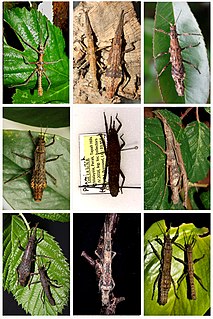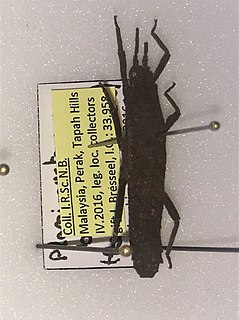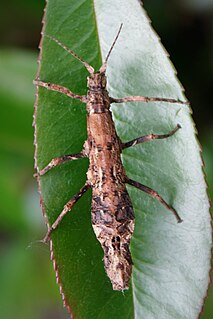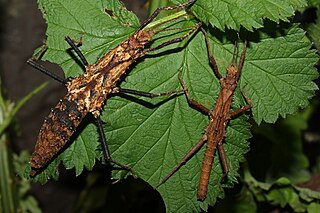
Sungaya is a monotypic genus of stick insects, containing the species Sungaya inexpectata. Its common name is the sunny stick insect, derived from the less commonly used sungay stick insect. The genus name refers to the locality of the holotype, i.e. the region where the insect was first collected. The species name is derived from the Latin as "inexpectatus" and means "unexpected".

The Heteropterygidae is a family of stick insects belonging to the suborder Euphasmatodea. Species can be found in Australasia, East and Southeast Asia. More than 130 valid species are descriebed.

Pylaemenes is a genus of stick insects in the family Heteropterygidae and subfamily Dataminae. It combines small to medium-sized, often brightly colored Phasmatodea species. Their representatives are found in large parts of Southeast Asia.

The genus Orestes combines relatively small and elongated Phasmatodea species from Southeast and East Asia.

Orestes draegeri is a species of stick insects in the subfamily Dataminae.

The Obriminae are the most species-rich subfamily of the Phasmatodea family Heteropterygidae native to Southeast Asia. It is divided into two tribe.

Datamini is the only tribe within the subfamily of the Dataminae from the order of the Phasmatodea. The representatives of this subfamily are on average not as large as those of the other two subfamilies belonging to the family of Heteropterygidae.

Heteropterygini is the only tribe within the subfamily of the Heteropteryginae from the order of the Phasmatodea in the family Heteropterygidae. With 19 representatives described, this subfamily represents both the species-poorest and that of the three subfamilies, to which the largest and most striking species are counted.

The genus Dares, which is mainly native to Borneo, combines relatively small and mostly dark-colored Phasmatodea species.

The genus Planispectrum combines very small and compact species from Southeast Asia.

Orestes dittmari is a species of stick insects in the subfamily Dataminae.

The genus Tisamenus native to the Philippines combines small to medium-sized species of stick insects.

Eubulides is a stick insect genus native to the Philippines.

Aretaon asperrimus is a species of insect in the Aretaon genus of the Phasmatodea order. The sometimes used common name thorny stick insect is a bit misleading, since the species does not correspond to the typical stick-like habitus and many other species are thorny as well.

Orestes mouhotii is an insect species belonging to the order of Phasmatodea. Because of its synyonym Orestes verruculatus, it is the type species of the genus Orestes. Because of its compact body shape, the species is sometimes referred to as small cigar stick insect.

Orestes bachmaensis is a Phasmatodea species native to central Vietnam.

Orestes guangxiensis is a representative of the genus Orestes.

Orestes japonicus, a stick insect, is a representative of the genus Orestes.

Orestes krijnsi is a species of stick insects native to Vietnam.

Orestes shirakii is a species of stick insects native to Taiwan.




















